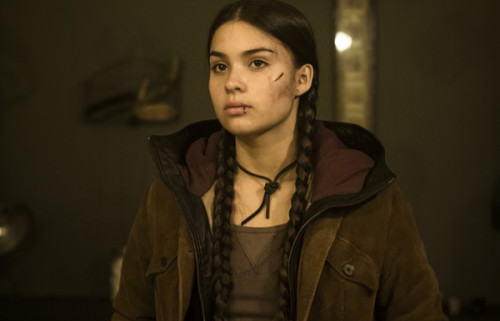Written by Amanda Morris.
How much courage must one young Mi’g Maq girl possess in order to endure and survive her mother’s suicide, her father’s imprisonment, and her own quest for vengeance? Rhymes for Young Ghouls answers this question in satisfying ways through layered storytelling, poetic cinematography, dark humor, pain, and a touch of the supernatural. All of this AND it passes the Bechdel Test!
Although the cliché of alcohol and drug abuse on the reservation plays a central role in the plot, the film rises above the expectations that this cliché sets up in surprising ways, drawing the viewer in with dialogue, artistry, strong acting, a truly heinous bad guy in Popper, the violent and vindictive Indian agent played by Mark Antony Krupa, and a soundtrack that enhances both active and quiet moments. Plus, it introduces viewers to one potential negative experience of Indian residential schools, which is a subject not covered in most K-12 classrooms.
[youtube_sc url=”https://www.youtube.com/watch?v=81JcYmXLcXo” title=”Rhymes%20for%20Young%20Ghouls%20official%20trailer”]
In Boarding School Blues: Revisiting American Indian Educational Experiences, Margaret Connell Szasz writes about power, position, and knowledge through these boarding schools in “Through a Wide-Angle Lens,” beginning with this statement: “Boarding schools go against the grain of human experience. By substituting an institutional setting for the traditional family, they intervene in the educational nurturing historically provided by home, kin group, and community . . . In Indian country, the subject of boarding schools always evokes an emotional response” (187-88). In Rhymes for Young Ghouls, this idea of interference and the breakdown of family, as well as a risky and brazen solution to this intervention is brought to life. Szasz continues, “The federal boarding schools, alongside the Residential Schools of Canada, left a decidedly mixed legacy, one that remains alive in Native communities across North America” (Boarding School Blues, 196). If you want a good idea about the horrific side of this legacy, Rhymes is the film to watch.
The film starts simply enough, with the following historical text in white on a black background, privileging the words and asking the viewer to consider this premise as the foundation of the story to come:
“The law in the Kingdom decreed that every child between the age of 5 and 16 who is physically able must attend Indian Residential School.
“Her Majesty’s attendants, to be called truant officers, will take into custody a child whom they believe to be absent from school using as much force as the circumstance requires.
“–Indian Act, by will of Her Majesty the Queen in Right of Canada”
The first image is a closeup of marijuana with blues music playing as the scene opens to reveal a woman and two men in a kitchen getting drunk and high on the Red Crow Indian Reservation in 1969. They are relaxed and counting up product to sell while getting drunk and then the couple, the parents of the film’s main character, Aila (Kawennahere Devery Jacobs), decide to drive away. Aila and her younger brother, Ty, are sitting and talking on the hood of the car when their parents stagger out of the house. Aila’s uncle, Burner, suggests that Aila, who is a little girl, be the one to drive. What happens next sets the rest of the film’s events in motion.

The next scene shows Aila’s father being arrested as he shouts to her, “Don’t look, Aila! Don’t look!” Of course Aila looks and sees her mother’s body hanging from a porch rafter as her voiceover says, “The day I saw my mother dead, I aged by a thousand years.”
This instant maturity might be the reason Aila decides to take over the marijuana business in order to pay Popper a “truant tax” so that she and her friends can stay out of the Residential School that he controls.

The refreshing part about this dark story is the calm confidence and self-assurance of an unapologetic Native female protagonist who is unafraid to take risks and clearly provides leadership to her friends and family. When her father returns from prison and finds her in charge instead of his brother, he says that they are supposed to take care of her, not the other way around. And he affirms this idea several times when he refers to Aila as a little girl. But the inexperienced and immature concept of a little girl is not the character that Jacobs portrays in Aila. In fact, this character is quite the opposite – worldwise, smart, practical, and sensitive. When it comes time to confront the domineering and violent Residential School truant officer, Popper, Aila and her friends execute a daring revenge plot that ends this sadistic man’s rein over the reservation community.

Winning such awards as Best Director at the American Indian Film Festival in 2014, Best Canadian Feature Film at the Vancouver International Film Festival in 2013, and Outstanding Actress in a Supporting Role (Roseanne Supernault) at the Red Nation Film Festival in 2014, Rhymes for Young Ghouls is a Native American film that challenges stereotypes of indigenous peoples while also telling a compelling story accessible to all. Originally released in May 2014, this film runs 88 minutes and can be streamed online via Amazon (free with Prime), or on Vudu (rental or purchase).
In the preface to Boarding School Blues, the editors warn against accepting any single interpretation of the Indian boarding school experience because there were a wide variety of experiences, both positive and negative. So I will similarly caution that this film does not represent ALL indigenous peoples’ experiences with the Indian boarding school or residential school systems, but it IS a good film to start the conversation about a subject that most people know nothing about. Incorporating such a film into a brief unit about the Indian boarding school experience would provide that dramatic and artistic touch that students enjoy, but a chapter from Boarding School Blues would also provide a balanced perspective.
Dr. Amanda Morris is an Associate Professor of Multiethnic Rhetorics at Kutztown University of Pennsylvania with a specialty in Indigenous Rhetorics.





